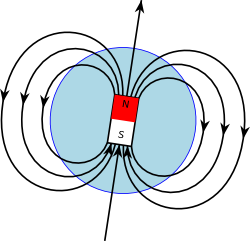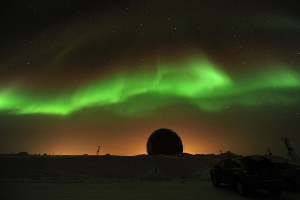The mystery of planets' magnetic field
Although we usually do not take much care of it, the magnetic field of our planet is of primary importance. On the one hand, it prevents solar wind from stripping our atmosphere and thus protects life on Earth. On the other hand, the compass used for centuries to navigate over sees, works because of it. Some species of migratory animals use the magnetic field to find their way, using the same principle. Finally, the magnetic field is the source of the spectacular auroras borealis, visible in countries close to the polar circle.
But despite its importance, this geophysical phenomenon still raises many questions. It is known that the turbulent motion of the liquid iron inside the Earth's core -- the so-called geodynamo -- is the source of the magnetic field. But we do not know how and when this phenomenon started, and neither how and when it will stop. Regarding other celestial objects, we generally only have hypotheses. It seems that Mars used to have a dynamo, but at some point it stopped and the planet would have lost its atmosphere at this occasion. Recent evidence suggests that the moon may have also had an active dynamo in its early history, although a different gravitational mechanism would likely have powered that dynamo.
How can we know what happened in the past? Rocks contain ferromagnetic particles which are like microscopic magnets. When it is very hot, a rock becomes liquid: think for instance to the lava coming out from a volcano. When the rock is liquid, ferromagnetic particles are free to move and they orient themselves in the direction of the ambient magnetic field, as a compass would do. As the rock cools down, these particles lock in the direction of the ambient field. They also retain information regarding the intensity of the magnetic field at the time the rock cooled down. These particles are hence a good way to study what was the magnetic field at that time. But these micro-magnets themselves emit a magnetic field of their own. Geophysicists of the MIT in the USA have a very sensitive instrument, called SQUID microscope, that can be used to get an “image” of the magnetic field generated by a very thin slice of rock. Specifically, each point of the image corresponds to the value of (the vertical component) of the magnetic field measured at that point, above the sample of rock at a constant given height.
Here begins the work of the mathematician: how to go back from the image of the field to the image of the ferromagnetic particles of the rock (that is technically called the remanent magnetism of the rock)? The equations giving the field in function of the remanent magnetism are well-known, but following them in the reverse direction is tough. Indeed, there exist so-called silent configurations: the effects of all the particles cancel out so that, eventually, the sample does not generate any magnetic field. This leads to both theoretical and practical problems. Theoretical, because it implies that there exist infinitely many configurations that produce the exactly same magnetic field. How should we define the “true” solution? It is thus necessary to set up additional hypotheses; for instance we can suppose that the particles are all oriented along the same direction. This hypothesis is reasonable for igneous rocks that have never been heated again or subsequently altered. In that case, we expect all micro-magnets to be roughly aligned in the same direction: the direction of the magnetic field at the time when the rock cooled down. The problems are also of practical nature: how to concretely compute the solution? Numerical considerations come up: the algorithms designed to solve the problem are easily perturbed by measurement noise or roundoff errors occurring during the computation. Designing robust algorithms to solve this problem is an ongoing subject of research, within a collaboration project named Impinge, between our research team, mathematicians of Vanderbilt University in the USA and geophysicists of the MIT.
Post written by Sylvain Chevillard (Inria). The author wishes to thank Eduardo Lima for reviewing this article and for his suggestions.
- [In French] Pour La Science n°424 - February 2013 - La magnétisme de la Lune, pages 34 to 41.
- Wikipedia page about the magnetic field of Earth.
- Web page of Impinge project.
Images
- Aurora borealis: by NASA Goddard Space Flight Center, published under Creative Commons 2.0 licence.
- Schematic magnetic field of a planet: by Wikimedia Commons user TStein, published under Creative Commons ShareAlike 3.0 licence. The original image has been rotated and slightly modified.
- Photography and measures of the magnetic field of a basalt rock: Eduardo Lima.



